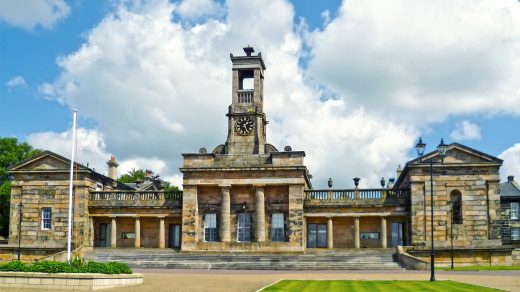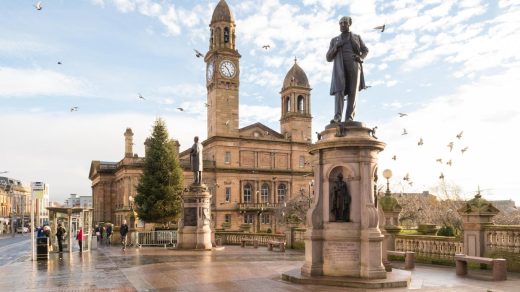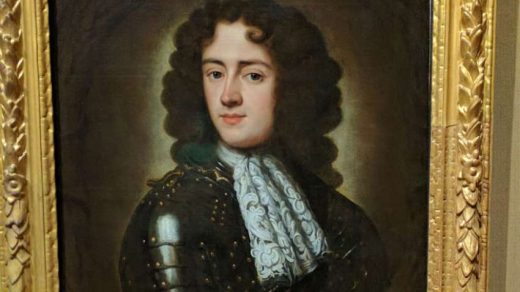Elgin (/ˈɛlɡɪn/; Scots: Ailgin; Scottish Gaelic: Eilginn, IPA: [ˈel(e)kʲɪɲ]) is a town (former cathedral city) and formerly a Royal Burgh in Moray, Scotland. It is the administrative and commercial centre for Moray. The town originated to the south of the River Lossie on the higher ground above the floodplain where the town of Birnie is. There, the church of Birnie Kirk was built in 1140 and serves the community to this day.
Elgin is first documented in the Cartulary of Moray in 1190 AD. It was created a royal burgh in the 12th century by King David I of Scotland, and by that time had a castle on top of the present-day Lady Hill to the west of the town. The origin of the name Elgin is likely to be Celtic. It may derive from ‘Aille’ literally signifying beauty, but in topography a beautiful place or valley. Another possibility is ‘ealg’, meaning both ‘Ireland’ and ‘worthy’. The termination ‘gin’ or ‘in’ are Celtic endings signifying little or diminutive forms, hence Elgin could mean beautiful place, worthy place or little Ireland.
History
The 9th century Pictish Elgin Pillar, found in the churchyard of St Giles’ Church in 1823

The discovery of the Elgin Pillar, a 9th-century class II Pictish stone, under the High Street in 1823 suggests there may have been an Early Christian presence in the area of the later market, but there is no further evidence of activity before Elgin was created a Royal Burgh in the 12th century. In August 1040, MacBeth’s army defeated and killed Duncan I at Bothganowan (Pitgaveny), near Elgin. Elgin is first recorded in a charter of David I in 1151 in which he granted an annuity to the Priory of Urquhart. David had made Elgin a royal burgh around 1130, after his defeat of Óengus of Moray. During David’s reign, the castle was established at the top of what is now Lady Hill. The town received a royal charter from Alexander II in 1224 when he granted the land for a new cathedral to Andrew, Bishop of Moray. This finally settled the episcopal see which had been at various times at Kinneddar, Birnie and Spynie. Elgin was a popular residence for the early Scottish monarchs: David I, William I, Alexander II and Alexander III all held court there and hunted in the royal forests.
Of these kings, Alexander II was Elgin’s greatest benefactor and returned many times to his royal castle. He established the two religious houses of the town, the Dominicans or Blackfriars on the west side and the Franciscans or Greyfriars in the east. Further to the east stood the Hospital of Maison Dieu, or House of God also founded during the reign of Alexander II for the reception of poor men and women.
Elgin Cathedral
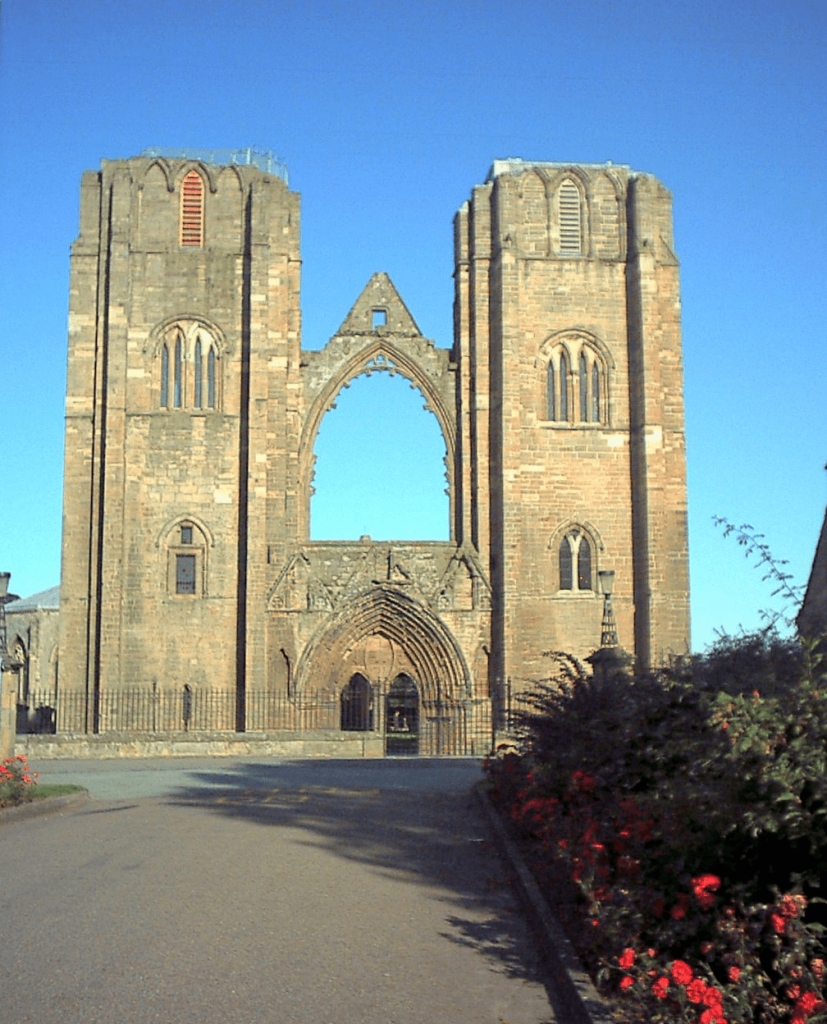
On 19 July 1224, the foundation stone of the new Elgin Cathedral was ceremoniously laid. The cathedral was completed sometime after 1242 but was completely destroyed by fire in 1270. The reasons for this are unrecorded. The buildings now remain as ruins date from the reconstruction following that fire. The Chartulary of Moray described the completed cathedral as “Mirror of the country and the glory of the kingdom”.
Edward I of England travelled twice to Elgin. During his first visit in 1296, he was impressed by what he saw. Preserved in the Cotton library now held in the British Library is the journal of his stay, describing the castle and the town of Elgin as “bon chastell et bonne ville”—good castle and good town. By his second visit in September 1303, the castle’s wooden interior had been burned while held by the English governor, Henry de Rye. As a result, he only stayed in Elgin for two days and then camped at Kinloss Abbey from 13 September until 4 October. King Edward was furious when David de Moravia, Bishop of Moray, joined Scotland’s cause with Bruce, and Edward appealed to the Pope who excommunicated the bishop, thus removing papal protection, causing him to flee to Orkney, then to Norway, only to return after Robert Bruce’s victories against the English. After Edward’s death in July 1307, Robert the Bruce retook Scotland in 1308, slighting castles to keep them out of English hands. David de Moravia, the Bishop of Moray at the head of his army, joined with Bruce and they slighted the castles of Inverness, Nairn and Forres before seizing and slighting Kinneddar Castle, which also housed English soldiers. He attacked Elgin castle to be twice repulsed before finally succeeding.
In August 1370 Alexander Bur, Bishop of Moray began payments to Alexander Stewart, Wolf of Badenoch, King Robert III’s brother, for the protection of his lands and men. In February 1390, the bishop then turned to Thomas Dunbar, son of the Earl of Moray, to provide the protection. This action infuriated Stewart and in May he descended from his castle on an island in Lochindorb and burned the town of Forres in revenge. In June he burned much of Elgin, including two monasteries, St Giles Church, the Hospital of Maison Dieu and the cathedral. Andrew of Wyntoun‘s Orygynale Cronykil of Scotland (a 15th-century history of Scotland) described this action by “wyld, wykked Heland-men”. The rebuilding of the cathedral took many years; but much of it has since crumbled away due to the inferior quality of the stone made available to the 15th- and 16th-century masons, while the 13th-century construction still remains. In 1506, the great central tower collapsed and although rebuilding work began the next year it was not completed till 1538.
From the Reformation to the eighteenth century
Elgin Cathedral
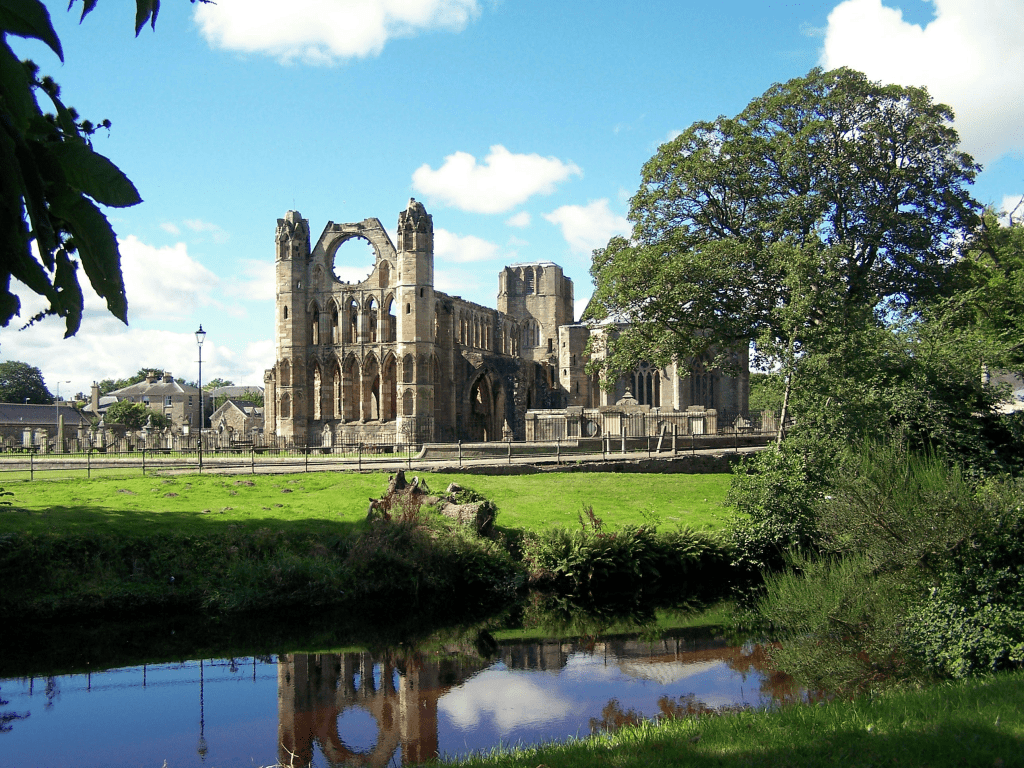
The citizens of Elgin and surrounding areas did not seem to object to the new religion following the Reformation. In 1568 the lead was stripped from the roof of the cathedral, by order of the Privy Council of Scotland. The lead was to be sold and the proceeds to go to the maintenance of Regent Moray’s soldiers, but the ship taking the lead cargo to Holland sank almost immediately on leaving Aberdeen harbour. Without this protection, the building began to deteriorate. In 1637, the rafters over the choir were blown down and in 1640 the minister of St Giles along with the Laird of Innes and Alexander Brodie of Brodie, all ardent Covenanters, removed and destroyed the ornately carved screen and woodwork that had remained intact. The tracery of the West window was destroyed sometime between 1650 and 1660 by Cromwell‘s soldiers. On Easter Sunday 1711 the central tower collapsed for the second time in its history but caused much more damage. The rubble was quarried for various projects in the vicinity until 1807 when, through the efforts of Joseph King of Newmill, a wall was built around the cathedral and a keeper’s house erected. Mountains of this rubble were cleared by one John Shanks, enabling visitors to view the ornate stonemasonry. Shanks was presented with an ornate snuffbox by the authorities, it is now in Elgin Museum, he is also honoured with a large tombstone in the eastern Cathedral precincts.
When Daniel Defoe toured Scotland in 1717, he visited Elgin and said:
In this rich country is the city, or town rather, of Elgin; I say city, because in antient time the monks claim’d it for a city; and the cathedral shews, by its ruins, that it was a place of great magnificence. Nor must it be wonder’d at, if in so pleasant, so rich, and so agreeable a part of the country, all the rest being so differing from it, the clergy should seat themselves in a proportion’d number, seeing we must do them the justice to say, that if there is any place richer and more fruitful, and pleasant than another, they seldom fail to find it out. As the country is rich and pleasant, so here are a great many rich inhabitants, and in the town of Elgin in particular; for the gentlemen, as if this was the Edinburgh, or the court, for this part of the island, leave their Highland habitations in the winter and come and live here for the diversion of the place and plenty of provisions; and there is, on this account, a great variety of gentlemen for society, and that of all parties and of all opinions. This makes Elgin a very agreeable place to live in, notwithstanding its distance, being above 450 measur’d miles [725 km] from London, and more, if we must go by Edinburgh.
The cathedral is known as the Lantern of the North. When Bishop Bur wrote to King Robert III, complaining of the wanton destruction done to the building by the King’s brother, the Wolf of Badenoch, he describes the cathedral as “the ornament of this district, the glory of the kingdom and the admiration of foreigners.” Chambers, in his Picture of Scotland, says:
It is an allowed fact, which the ruins seem still to attest, that this was by far the most splendid specimen of ecclesiastical architecture in Scotland, the abbey church of Melrose not excepted. It must be acknowledged that the edifice last mentioned is a wonderful instance of symmetry and elaborate decoration; yet in extent, in loftiness, in impressive magnificence, and even in minute decoration, Elgin has been manifestly superior. Enough still remains to impress the solitary traveller with a sense of admiration mixed with astonishment.
Lachlan Shaw in his History of the Province of Moray was equally impressed when he wrote
the church when entire was a building of Gothic architecture inferior to few in Europe.
Prince Charles Edward Stuart travelled to Elgin from Inverness in March 1746 and, falling ill with a feverish cold, stayed for 11 days before returning to await the arrival of the king’s army. He stayed in Elgin with Mrs Anderson, a passionate Jacobite, at Thunderton House. She kept the sheets that the Prince slept on and was buried in them a quarter of a century later. The Duke of Cumberland passed through the town on 13 April, camping at Alves on the way to meet the Prince in battle on Drummossie Muir. After the battle, William Boyd, 4th Earl of Kilmarnock, one of the Prince’s generals, was captured and taken to London and eventual execution, but he wrote to his friend from prison about his indebtedness to the shoemakers of Elgin:
Beside my personal debts mentioned in general and particular in the State, there is one for which I am liable in justice, if it is not paid, owing to poor people who gave their work for it by my orders. It was at Elgin in Murray, the Regiment I commanded wanted shoes. I commissioned something about seventy pair of shoes and brogues, which might come to 3 shillngs or three shillings and sixpence each, one with the other. The magistrates divided them among the shoemakers of the town and country, and each shoemaker furnished his proportion. I drew on the town, for the price, out of the composition laid on them, but I was afterwards told at Inverness that, it was believed, the composition was otherwise applied, and the poor shoemakers not paid. As these poor people wrought by my orders, it will be a great ease to my heart to think they are not to lose by me, as too many have done in the course of that year, but had I lived I might have made some inquiry after but now it is impossible, as their hardships in loss of horses and such things, which happeened through my soldiers, are so interwoven with what was done by other people, that it would be very hard, if not impossible, to separate them. If you’ll write to Mr Innes of Dalkinty at Elgin (with whom I was quartered when I lay there), he will send you an account of the shoes, and if they were paid to the shoemakers or no; and if they are not, I beg you’ll get my wife, or my successors to pay them when they can …
Nineteenth century.
Dr Grays Hospital.

In the 19th century, the old medieval town of Elgin was swept away. The first major addition to the town centre was the Assembly Rooms, built in 1821 by the Trinity Lodge of Freemasons, at the corner of High Street and North Street. In 1819, Dr Gray’s Hospital was built on unused ground. The building has imposing columns and distinctive dome. Dr Alexander Gray, a doctor who worked for and made his fortune with the East India Company, endowed £26,000 for the hospital. In 1828 the new parish church of St Giles was built at a cost of £10,000. L. General Andrew Anderson, born in Elgin, also of the East India Company, died in 1824 and bequeathed £70,000 to the town to found an institution for the welfare of the elderly poor and for the education of orphans. The Anderson Institution was built in the east end of the town in 1832 with accommodation for 50 children and ten elderly people. The Burgh Court House was built in 1841, the museum was completed in 1842 and the Sheriff’s Court Complex was built in 1866.
The Morayshire Railway was officially opened in ceremonies at Elgin and Lossiemouth on 10 August 1852, the steam engines having been delivered to Lossiemouth by sea. It was the first railway north of Aberdeen and initially ran only 5+1⁄2 miles (9 km) between Elgin and Lossiemouth. It was later extended south to Craigellachie. The Great North of Scotland Railway took over the working of the line in 1863 and bought the company in 1881 following the Morayshire Railway’s return to solvency from crippling debt. The railway and Lossiemouth harbour became very important to Elgin’s economy.
The town was becoming prosperous, and by 1882 it had a Head Post Office with a savings bank, insurance and telegraph departments, and branches of the Bank of Scotland and the British Linen Company, Caledonian, Commercial, North of Scotland, Royal and Union Banks, and the National Securities Savings Bank, offices or agencies of 48 insurance companies, five hotels, and a newspaper. It was not until the 20th century, however, that the separate villages of Bishopmill and New Elgin would be incorporated into the town.
The Cooper Park drill hall was completed in 1908.
The war memorial in Elgin dates from 1921 and represents “Peace and Victory”. It was designed by Percy Portsmouth.
Geography and geology
The modern town straddles the River Lossie, with the suburbs of Bishopmill to the north and New Elgin to the south. Permo–Triassic rocks, rare in Scotland, are commonly found around Elgin. These are composed of aeolian sandstone formed when this area was subjected to desert conditions. Quarry Wood, on the town’s edge, has a formation nicknamed Cuttie’s Hillock which produced the internationally known fossils called the Elgin Reptiles. In the Elgin district, boulders belonging to the lowest group of Jurassic strata, Oxford clay and chalk are found both in glacial deposits and on the surface of the ground. The largest of these deposits is at Linksfield, where limestone and shale lie on boulder clay. There is a large hill in Elgin’s town centre, often viewed as the highlight of the Elgin tourist trail.

